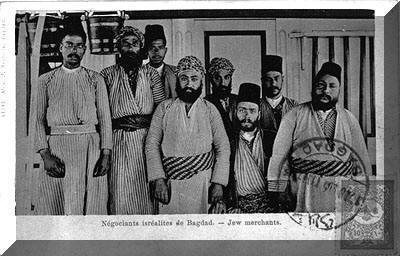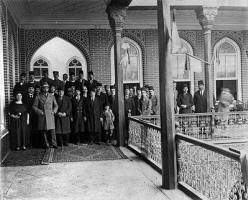The Jewish Community of Baghdad, Iraq
Reposted from Beit Hatfutsot
In recent years [late 19th and early 20th century] Jews in Iraq were permitted to live in two cities only – Baghdad and Basra. They numbered about 500 in total. The community in Baghdad was founded in the mid-eighth century and from the 9th-11th centuries was the seat of the Exilarch (Resh Galutah). During the Gaonate the Jews lived in a special quarter (“Dar Al-Yahud”) and the “Jewish Bridge” connected them to the rest of the city. The Yeshivot of Sura and Pumbedita were established in Baghdad at the end of the 9th century. The city was an important center for the Karaite movement.
In the 12th century the community reached its peak and Benjamin of Tudela reports that it numbered approximately 40,000 Jews, 28 synagogues, and ten yeshivot. Jews were active in the fields of medicine, pharmacy, as goldsmiths, and in trade. Under Mongol rule (1258-1335) the physician Sa’d Al-Dawla was appointed as director of the financial administration of Iraq, and Chief Vizier of the Mongol Empire. After the death of the Sultan in 1291, he was executed on the fabricated charge of not having given the Sultan the appropriate medical attention.
After the conquerors converted to Islam at the start of the 14th century, they renewed all the decrees and heavy taxes which applied to all “Unbelievers”. With the conquest of Baghdad by Tamerlane (1393) many Jews fled to Kurdistan and Syria and Baghdad remained almost without Jews until the end of the 15th century.
During the first part of the Ottoman occupation (1534-1623) there was an improvement in the Jews’ situation. There were 250 Jewish houses in the city, of a total of 25,000 houses. From 1623-38 Baghdad was under Persian rule and the Jews were greatly relieved when Baghdad was once again conquered by sultan Murad IV. the day of the conquest Tevet 16th (5399) was fixed as “yom nes” (day of miracle).
From the second half of the 18th century through the beginning of the 19th, Turkish rule deteriorated and the attitude to the Jews became harsh. Many wealthy members of the community fled to Persia and other countries, among them David B. Sassoon, who moved his business to India. At that time 6,000 Jewish families were resident in Baghdad led by a Pasha known as “King Of The Jews”. With the opening of the Suez Canal (1869) the situation of the city’s 20,000 Jews improved – along with the general economic situation – and many Jews from other localities settled there. In 1884 there were 30,000 Jews in Baghdad and by the beginning of the 20th century – 50,000. The greatest of the Baghdad rabbis, rabbi Joseph Hayyim Ben Eliahu Mazal-Tov (1834 – 1909), never accepted public financial assistance, his name is famous in the Jewish world, especially among the Baghdad-version (of prayer book) communities in Israel, England, India, Singapore, Manila etc.
Until the British occupation of World War I, the Jews suffered from extortion and the cruelty of the local authorities. Many young men were recruited into the army service to serve in the dangerous Caucasus mountains. With British entry to Baghdad on February 3, 1917 (fixed as yom nes 17th Adar) there began a period of freedom for the Jews of Baghdad and many of them were employed in the civil service. When the state became independent in 1929 there was an increase in anti-Semitism, especially after the appearance of the German ambassador A. Grobbe in Baghdad (1932). Jewish clerks were dismissed and in 1936 Jews were murdered and their institutions bombed. In the days of the pro-axis revolution of Rashid Ali Al-Kilani on June 1-2, 1941 riots against the Jews took place with the passive support of both the army and police. between 120-180 people were killed and more than 800 wounded. The value of the looted property was estimated at 4,000,000. Thousands left the city and only returned when they heard that the situation had improved.

Students from “Alliance” Baghdad on a biking trip, 1939 (Beit Hatfutsot, the Visual Documentation Center; courtesy: Yaacov Zilcha, Tel Aviv).

Merchants in Baghdad. (Beit Hatfutsot, the Visual Documentation Center).

King Faisl visiting the Alliance Lora Kaduri school, 1924. (Beit Hatfutsot, the Visual Documentation Center).

Memorial ceremony of the philanthropist Menachem Zalah Daniel, leader of the Jewish community of Baghdad, who contributed to the “Magen Avraham” synagogue in Beirut, Lebanon. Beirut, 1931. (Beit Hatfutsot, the Visual Documentation Center).
In 1945 there were frequent demonstrations against the Jews and especially against Zionism, and with the proclaimed partition of Palestine in 1947, the Jews were in danger of their lives. Many received harsh legal sentences and were forced to pay heavy fines. The number of Jews in Baghdad decreased from 100,000 to 77,000 and after the mass exodus to Israel (Operation Ezra and Nehemiah) only about 5,000 Jews remained. In 1968 there were only 2,000 Jews left. With the establishment of Israel hundreds of young Jews were arrested on charges of Zionist activity and two Zionist leaders were publicly hanged in Baghdad. On January 27, 1969 nine other Jews were hanged on charges of spying for Israel.
Until operation “Ezra and Nehemiah” there were 28 Jewish educational institutions in Baghdad, 16 under the supervision of the community committee and the rest privately run. The number of pupils reached 12,000 and many others learned in foreign and government schools. About 400 students studied medicine, law, economics, pharmacy, and engineering. In 1951 the Jewish school for the blind was closed; it was the only school of its type in Baghdad. The Jews of Baghdad had two hospitals in which the poor received free treatment, and several philanthropic services. Out of 60 synagogues in 1950, there remained only seven in 1960.
From the end of the Ottoman period until 1931 there was a “General Council” of 80 members, among them 20 rabbis. A law was passed in early 1931 to permit non-rabbis to assume the leadership. Despite this, in 1933 R. Sassoon Kadoorie was elected and in 1949 Ezekiel Shemtob succeeded him. Kadoorie returned to his position in 1953. In December 1951 the government abolished the rabbinical court in Baghdad.
During the tenth century there were two distinguished Jewish families in Baghdad, Netira and Aaron. At the end of the tenth century R. Isaac B. Moses Ibn Sakri of Spain was the Rosh Yeshiva. In the 12th century the Exilarch Daniel B. Chasdai was referred to by the Arabs as “Our Lord, The Son Of David”. The Baghdad community reached the height of its prosperity during the term of office of Rosh Yeshiva Samuel B. Ali Ha-Levi, an opponent of Maimonides, who raised torah study in Baghdad to a high level. R. Eleazar B. Jacob Ha-Bavli and R. Isaac B. Israel were Rashei Yeshivot during the late 12th century through the middle of the 13th century. Notable personalities in the 18th and 19th Abdallah Somekh, who founded a rabbinical college, Beit Zilkha; R. Sasson B. Israel; Jacob Tzemach; Ezekiel B. Reuben Manasseh; Joseph Gurji; Eliezer Kadoorie; and Menachem Daniel. Until 1849 the community of Baghdad was led by a president (“Nasi”), who was appointed by the vilayet governor, and who also acted as his banker. the most renowned of these leaders were Sassoon B. R. Tzalach, the father of the Sassoon family, and Ezra B. Joseph Gabbai.
The first Hebrew printing press in Baghdad was founded by Moses Baruch Mizrachi in 1863. other printing presses were R. Ezra Reuben Dangoor, and Elisha Shochet. A Hebrew weekly, Yeshurun, of which only five issues were published, appeared in 1920. this was the last attempt at Hebrew journalism in Baghdad.



